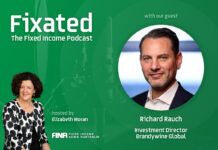
From Chris Iggo, Chief Investment Officer, Core Investments, AXA Investment Managers.
Markets are getting close to pricing out any interest rates cuts for 2024. That seems a little extreme. In the US, sticky prices in parts of the services sector have stalled the disinflation process, but the core personal consumption expenditure (PCE) deflator– the Federal Reserve’s (Fed) key measure of inflation – looks to be moving in the right direction, even if the consumer price inflation index (CPI) is a little less well behaved. Long-dated Treasury and other sovereign benchmark bonds do not look overly exciting and won’t until rates are eased. Before that happens, credit markets are more interesting, with carry dominating the return picture. Short duration and spread continue to be the dominant themes in bond markets.
One, two but not six
The short-term view is that bonds look a little oversold. Yield volatility at the long end of the curve can be driven by several things – changing views on monetary policy, economic data and geopolitical events. What is more interesting is the shifts we have seen in terms of expectations about what central banks will do this year. Predictions for where policy rates will be at the end of 2024 have changed markedly. This has been most extreme in the US where the market has shifted from 3.65% to just shy of 4.90%. In other words, from expecting six cuts from the Fed, the market is now pricing in less than two. No wonder fixed income returns are negative year to date.
At the moment it is hard to see where bonds go. The potential for escalation in the Middle East could eventually start to impact global markets more meaningfully. Higher oil prices would disrupt the inflation and growth outlook. Together with the ongoing Ukraine conflict, there is a potential risk-off scenario where bonds benefit from safe-haven flows out of risk assets. However, this is hard to predict and trade. For now, the underlying fundamental and policy story needs to be monitored closely.
Do not mention hiking
A notable absence of suggestions over the notion that the Fed might need to hike rates has been from the Fed itself. Chair Jerome Powell pushed back on rate cut expectations at the International Monetary Fund Spring meetings in Washington, recognising the stalling of the disinflation process in the US. However, there is no public record of Fed officials admitting they have shifted from rate cuts to rates on hold to rate hikes. But there is a lack of confidence among investors that the Fed is on top of the inflation situation and, if it isn’t, what can it do about it.
Also read: Fixed Income Leaders – Snippets from a BetaShares panel
Stickier still
The bearish case for US bonds is that the Fed does hike and explicitly raises its long-term estimate of the neutral rate. Say the neutral rate is 3.5%-4.0% and the yield curve reverts to being positively sloped, putting 10-year yields at 5.0%-5.5%. That could be justified by inflation remaining stickier and there being a higher term premium because of concerns over the US fiscal situation. This is not a forecast, but it is a scenario that investors should consider. Treasury yields have been below 5% since the global financial crisis – a period that saw massive central bank buying and then a pandemic that stalled the global economy for several quarters. What I am suggesting is that 5%-6% would not be abnormal historically for an economy that looks as though it can sustain nominal growth in the 5%-7% range.
Making up
Even without this scenario happening, the outlook for long duration in Treasuries is only moderately exciting if inflation and growth are lower and the Fed cuts rates aggressively. I did some number crunching this week and if the current income return on the Treasury index stayed the same, so that the total return on a Treasury portfolio would mostly come from carry, it will take until mid-2029 for all the losses realised since September 2020 (when the total return index peaked) to be made good. The drawdown from the peak in the index is still ongoing in Treasuries, in contrast to global equities and high yield. Short-duration investors have done much better. The drawdown from the Fed hiking impact on total returns ended in November of last year for the one-to-three-year part of the US corporate bond market. Higher carry and shorter duration have been the winning strategies in fixed income and may continue to be so.
Better carry
But the past is the past. Few alpha-seeking investors would have held a passive Treasury portfolio for the last five years. What most of my readers will be interested in is what happens in the next year given the Treasury market sets the tone for other bond and credit markets and risk assets in general. The 10-year Treasury yields just under 4.6%. Yields on short-dated bonds are higher. The weighted yield on the ICE US Treasury market index is 4.8%. The income return on that index for the last year has averaged 22bp per month, or 2.7% per year. That has been rising and will rise further as the average coupon on the market increases. So, the make-good point on the Fed tightening era losses will come more quickly than suggested above. The Treasury market should return between 4% and 5% going forward. Add on another 90bp-100bp for investment grade credit and 350bp-400bp for high yield and you have an interesting US fixed income market. Any Fed hike will disrupt the returns for the US and other markets, but we are in a higher yield world now so income is what investors should be looking at from bonds. Stable yields would not be a bad outcome (so far, the market has not re-tested that 5% level on 10-year Treasury bonds).
Art of noise
There is no appetite for killing economic growth just to get that additional 50bp-100bp lower inflation rate, especially when pricing behaviour post-COVID-19 has not normalised in some sectors and is certainly not impacted by slight changes in the overnight cost of money. At this moment, central banks cannot raise rates because it would scupper their credibility and cannot rush to ease because it would scupper their credibility. Market interest rates and bond yields reflect that. Tactically, Treasuries and gilts are a buy here, and credit has become more attractive over the last month given the back-up in yields and the widening of spreads. The year of the bond is hard going, but carry should carry us home.
(Performance data/data sources: Refinitiv DataStream, Bloomberg, as of 18 April 2024, unless otherwise stated). Past performance should not be seen as a guide to future returns.

































